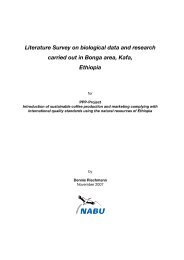Flora Biodiversity Assessment in Bonga, Boginda and Mankira Forest
Flora Biodiversity Assessment in Bonga, Boginda and Mankira Forest
Flora Biodiversity Assessment in Bonga, Boginda and Mankira Forest
Create successful ePaper yourself
Turn your PDF publications into a flip-book with our unique Google optimized e-Paper software.
2.12 An attempt was made to collect lichens, mosses, liverworts, epiphytes, <strong>and</strong> fungi. These<br />
plants were not encountered with<strong>in</strong> 1m X 1m quadrants. However, outside the quadrant,<br />
on a tree bole, branches <strong>and</strong> dead woods quite large amount of such plants were<br />
observed. Fern species that are encountered with<strong>in</strong> 1 m X 1m are recorded.<br />
2.13 Each plant species encountered with<strong>in</strong> transect is identified by its vernacular <strong>and</strong><br />
scientific names <strong>and</strong> tallied. Most of the trees <strong>and</strong> shrubs are identified. Those species<br />
that could not be identified on the field were taken to the AAU National Herbarium, for<br />
identification. Trees <strong>and</strong> shrubs less than 10 cm diameter <strong>and</strong> higher than 1.3 meter are<br />
considered as sapl<strong>in</strong>gs. Tree, shrub <strong>and</strong> lianas less than 1.3 meters high are recorded as<br />
regeneration.<br />
2.14 With<strong>in</strong> each 1m X 1m quadrant small herbaceous plants, grasses, trees <strong>and</strong> shrub<br />
seedl<strong>in</strong>gs were surveyed (photo 19 & 20). Tree <strong>and</strong> shrub seedl<strong>in</strong>gs are recorded<br />
separately.<br />
2.15 Important observations noted as threats to forest are:<br />
♦ Agricultural expansion, both for subsistence <strong>and</strong> commercial purpose, (<strong>in</strong>clud<strong>in</strong>g fire)this<br />
phenomena is pressuriz<strong>in</strong>g the forests <strong>in</strong> almost all directions.<br />
♦ Settlement (wood for construction <strong>and</strong> fuel); settlements <strong>in</strong> the area seem to be formed<br />
as a competition for l<strong>and</strong> with no pattern.<br />
♦ Free graz<strong>in</strong>g <strong>in</strong> the forest.<br />
3 RESULTS<br />
In this section major l<strong>and</strong> covers <strong>and</strong> their extent is analyzed based on remote sens<strong>in</strong>g <strong>and</strong><br />
GIS; number of <strong>in</strong>dividuals <strong>and</strong> species recorded with<strong>in</strong> each stratum are presented.<br />
3.1. Major l<strong>and</strong> covers<br />
Seven major l<strong>and</strong> covers are identified, namely Bamboo <strong>Forest</strong>, Dense <strong>Forest</strong>, Disturbed<br />
<strong>Forest</strong>, Intensively Cultivated, Moderately Cultivated, Highly Disturbed <strong>Forest</strong>, Wetl<strong>and</strong> (map 2<br />
& figure 1). The total size of the study area <strong>and</strong> extent of each l<strong>and</strong> cover is illustrated <strong>in</strong><br />
Table 1 below.<br />
12



